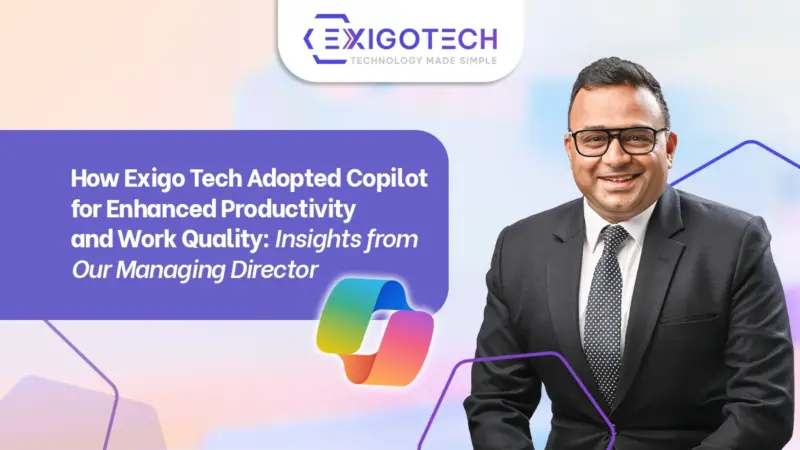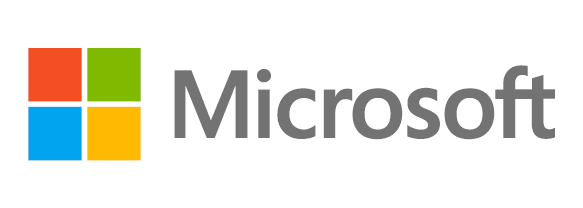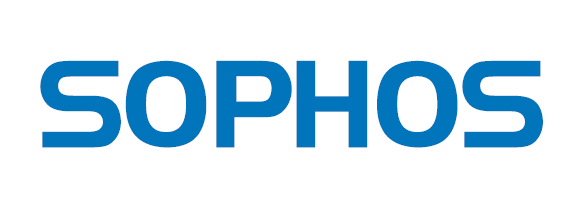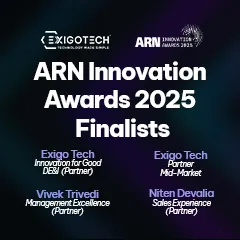At Exigo Tech, we are dedicated to empowering businesses with innovative technology solutions like AI (Artificial Intelligence) to streamline operations and enhance productivity. As a firm believer in leading by example, we recently embarked on our own journey to implement Microsoft Copilot within our organisation. We understand the transformative power of innovative technologies in driving business success. Hence, we believe that this experience will not only enhance our own operations but also enable us to bring these valuable insights to our clients.
In this blog, we will showcase our journey of adopting Copilot through insights from our Managing Director, Mr. Vivek Trivedi. By sharing our Copilot adoption story, we aim to highlight our expertise and reassure businesses that if we can successfully implement and benefit from this technology, so can you. With a successful implementation of Copilot in our organisation, we have positioned ourselves as trusted partners in Copilot implementation for businesses across various sectors.
An Overview of Microsoft Copilot
Microsoft Copilot represents a significant advancement within AI that enhances user productivity across a wide array of tasks. It is an innovative AI assistant designed to streamline workflows within various Microsoft applications. By leveraging the power of advanced AI, Copilot integrates seamlessly with tools like Microsoft 365 and Dynamics 365, providing users with intelligent assistance and automation. This integration allows businesses to automate repetitive tasks, generate insightful data analysis, and improve overall efficiency.
Copilot’s ability to understand and respond to user inputs in a highly contextual manner makes interactions more intuitive and effective, ultimately helping businesses achieve their goals more efficiently.
Our Copilot Adoption Journey: Insights from Our Managing Director
To provide a deeper understanding of our approach and experience with Microsoft Copilot implementation, we had a Q&A session with our Managing Director, Vivek Trivedi. Let’s find the snippets from that discussion below. It includes insights into our decision-making process, the specific features that attracted us to Copilot, and the challenges we encountered.
This candid conversation offers an overview of our journey and the practical steps we took to successfully adopt Copilot in our organisation.
Q: What motivated us to consider adopting Microsoft Copilot?
Vivek- “We are always focused on agility, positive change, and reflecting on how we do our work. AI is becoming a part of everything, and we wanted to explore how it could improve our efficiency and work quality. This led us to consider Copilot. Additionally, as a company that offers Copilot to our clients, it was crucial for us to have experience with the technology first. We wanted to ensure that we could provide the best solutions while overcoming potential challenges.”
Q: Which features of Copilot really made us consider Copilot?
Vivek- “The main features we were interested in were the future way of working with AI and how it could enhance business efficiency. We wanted to see not just time savings but also an improvement in the quality of our outputs. It’s about doing tasks better, not just faster. Copilot’s potential to provide quality outputs and insights was a key factor in our decision.”
Q: Who was involved in the decision-making process, and what roles did they play?
Vivek- “Alpesh Prajapati, our Practice Manager for Microsoft 365 and Modern Workplace Technologies played a crucial role in the decision-making process. His expertise in the Microsoft ecosystem helped us in guiding the assessment and implementation phases, ensuring that Copilot was a good fit for our organisational needs.”
Q: What were the organisation’s goals or objectives that we thought could be achieved with Copilot?
Vivek- “Our primary goals were to enhance productivity, improve the quality of our outputs, and save time on routine tasks. We were not looking for any magical solutions but rather practical enhancements that could significantly improve our day-to-day tasks.”
Q: How did we assess the readiness of the organisation before fully rolling out Copilot?
Vivek- “We conducted a readiness assessment through the Copilot Assessment Toolkit, which included evaluating data management and security protocols. This toolkit, enhanced by our own experiences and Microsoft’s best practices, helped us know our preparedness and identify areas needing improvement.”
Q: What implementation process did we follow for Microsoft Copilot adoption?
Vivek- “We started with a thorough assessment to identify gaps in data structuring and security, which are crucial for AI implementation. We then obtained around 10 to 20 Copilot licences and distributed them across 4 to 5 departments. We used our Center of Excellence (CoE) to gather feedback and insights from these departments, which helped us understand how effectively Copilot was being utilised. This phased approach ensured a more structured and informed rollout.”
Q: How did our existing infrastructure help the implementation of Copilot?
Vivek- “Our existing use of Microsoft SharePoint as the primary repository was a significant advantage. This setup aligned well with Copilot’s requirements and saved us considerable time. Having a well-established infrastructure in place made the technical integration smoother and more efficient.”
Q: What were the challenges faced during the implementation, and how did we overcome them?
Vivek- “The main challenges were related to data security and ensuring the proper handling of information. We needed to enhance our security protocols and ensure that sensitive data was appropriately protected. Another challenge was overcoming initial misconceptions among the workforce, who underestimated Copilot’s capabilities, thinking it was similar to a basic chatbot. However, through our CoE, we provided the necessary insights to demonstrate Copilot’s full range of functionalities.”
Q: How did we communicate the decision to adopt Copilot to the entire organisation?
Vivek- “We communicated the decision through internal announcements and departmental meetings. We emphasised the benefits of Copilot and outlined the phased implementation plan, making sure everyone understood the process and their role in it.
Q: What kind of training and support was provided to employees?
Vivek- “We organised weekly sessions to share experiences, address challenges, and provide hands-on training. Our Center of Excellence (CoE) played a pivotal role in this process, serving as a repository of knowledge and a platform for continuous learning. This support system helped employees understand the full range of Copilot’s capabilities and how to leverage them effectively.”
Q: How did we address any concerns or questions from employees about Copilot?
Vivek- “We actively engaged with employees through feedback sessions and the CoE, addressing concerns about data security and misconceptions about Copilot’s capabilities. We demonstrated real-world use cases and provided clear guidance on how Copilot could be utilised beyond basic tasks.”
Q: What kind of training programs were developed to prepare employees for using Copilot?
Vivek- “As I said earlier, we had weekly meetings to discuss actual challenges and solutions. The main focus was to understand practical challenges and their solutions rather than the set or pre-defined training program. The CoE was critical in this process, providing a centralised resource for learning and best practices. Our training was focused on practical applications and encouraging a deeper understanding of Copilot’s potential.”
Q: What was the role of our Centre of Excellence (CoE)?
Vivek- “The CoE was critical in managing the Copilot implementation. It served as a hub for feedback, training resources, and best practices. The CoE ensured that knowledge was shared across departments and that any issues were addressed promptly, facilitating a smoother adoption process.”
Key Insights and Learnings
Through our journey with Copilot, we have gained invaluable insights that we believe can benefit other businesses considering the implementation of Copilot.
- Strategic Planning: Clear strategic alignment and planning are essential for successful Copilot integration.
- Employee Engagement: Proactively involving employees and providing them adequate training boosts acceptance and proficiency with the new technology.
- Continuous Improvement: Optimising processes post-implementation ensures ongoing improvement and maximises the benefits of Copilot.
Conclusion
Our journey with Microsoft Copilot has been a valuable experience, demonstrating how AI can drive significant improvements in productivity and work quality. This journey has been both challenging and rewarding for us at Exigo Tech. We are now better positioned to help other organisations leverage Copilot in their daily operations to enhance productivity and operational effectiveness.
Begin Your Copilot Adoption Journey with Exigo Tech
Whether you are looking to enhance collaboration, streamline operations, or innovate your business processes, we are ready to support your organisation’s digital transformation journey and help you discover the power of Copilot.
You can start your Copilot journey with Exigo Tech’s readiness assessment to evaluate your organisation’s preparedness for Copilot adoption. It includes:
- Comprehensive Evaluation: Detailed review of your current infrastructure to assess readiness for Copilot implementation.
- Customised Recommendations: Actionable insights and strategies tailored to your unique needs to ensure a seamless transition to Copilot.
- Expert Guidance: Ongoing support and guidance from our team of experts to help you throughout the readiness process.
If you still have any doubts or questions about Copilot, feel free to reach out to us at or call us at 1300 EXIGOTECH (394 468).
 Australia
Australia Singapore
Singapore Philippines
Philippines India
India Anthony Kayem | Jul 29, 2024
Anthony Kayem | Jul 29, 2024









